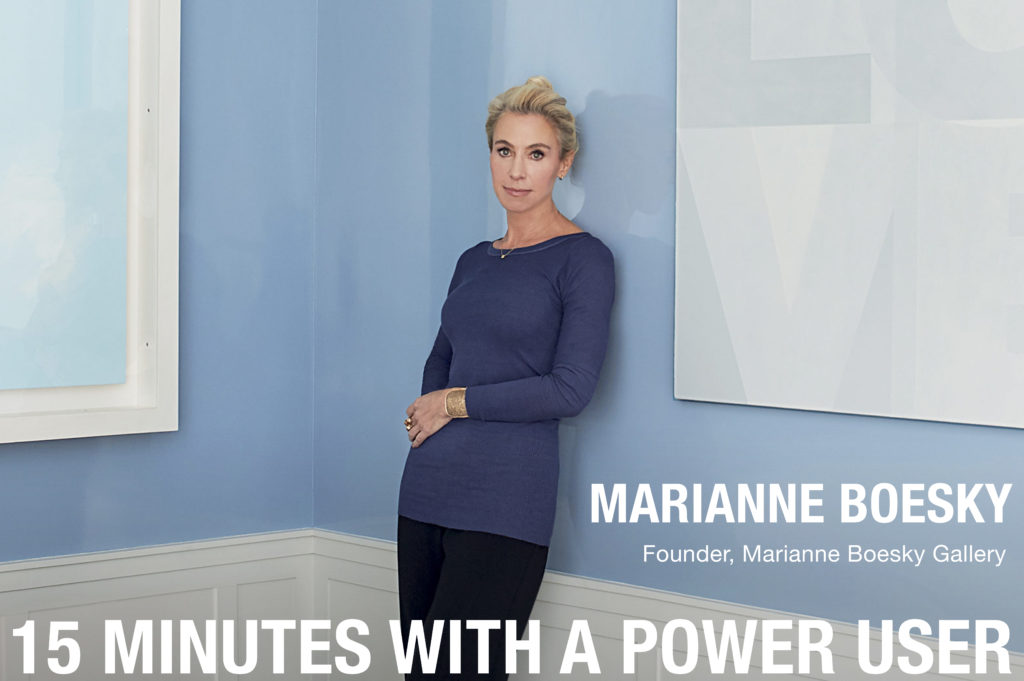15 Minutes With a Price Database Power User: Gallerist Marianne Boesky


Artnet Price Database Team

There is only one tool trusted by art world insiders to buy, sell, and research art: the artnet Price Database. Its users across sectors—from auction houses to museums, galleries to government institutions—represent the art world’s most important players. We’re taking 15 minutes to chat with some of the artnet Price Database’s power users to get their take on the current state of the market and how they’re keeping up with the latest trends.
In 1996, art dealer Marianne Boesky founded her eponymous gallery, and art was forever changed as the gallery introduced the world to Takashi Murakami and Yoshitomo Nara, who would go on to become international art stars. Marianne Boesky Gallery has since experienced several location changes, as well as artist representation shake-ups. Yet in the more than two decades since Marianne first opened her gallery’s doors, the business has grown to encompass three locations—two in Chelsea and one in Aspen, Colorado—as well as a fresh lineup of artists including such luminaries as Frank Stella and Jennifer Bartlett.
We spoke with Marianne about her history of collecting, the effect of real estate on her business, and where she turns for inspiration outside of the art industry.
You made the decision to close your East Village space in 2016 in favor of expanding your gallery in Chelsea. What impact has gallery location and real estate had on your business?
For me, stasis is like death, so shifting locations through time has always been part of my agenda and trajectory for the gallery. It is important to provide new and different spaces and contexts for our artists to show in. This was part of the strategy for taking the 507 W. 24th Street location, adjacent to the 509 flagship, and also for opening the space in Aspen. As part of the expansion in Chelsea, I connected 509 and 507 from inside to create a fluidity between them. This gives the artists, and me, more opportunity to think about how to engage the exhibition spaces, whether we do two discrete shows concurrently or a more expansive show across both. And we’ve had artists, like Pier Paolo Calzolari and Serge Alain Nitegeka, do site-specific installations in the connecting corridor. In essence, it’s given the Chelsea space more longevity and opportunity.
How do collectors outside of New York differ from those based here?
Collectors are completely unique individuals. In my experience, geography has not been a particular factor in collectors’ differing styles and preferences. More so, collectors share commonalities across borders. Those that I have strong and longstanding relationships with share an insatiable curiosity for new and different ideas and visions.
You recently began representing the irreverent and sculptural painter Gina Beavers. What qualities do you look for in new artists, and what determines whether you add someone to your roster?
That’s a difficult question to answer, because there isn’t a list of criteria or a template. It’s very much about a connection with the artist and the work, and the experience that leads to a relationship can be, and frequently is, very different. In the case of Gina, I found it incredibly compelling how her work speaks to critical dialogues within art production and within our broader social universe.
What collecting trends have you been surprised by? Has there ever been something you thought would never sell?
Always! It may not always make sense or follow conventional wisdom, but “sale-ability” is one of the lesser considerations for me when I am deciding to show an artist—much to my accountant’s chagrin! The beauty, however, is that the art community rewards risk-taking. When I show something that may be labeled as “impossible to sell,” I am often happily surprised by the outpouring of support for that work.

The Haas Brothers, Madonna (Installation view), Marianne Boesky Gallery, 2019. Courtesy of the artist and Marianne Boesky Gallery, New York and Aspen. © The Haas Brothers. Photo: Object Studies
What are you most excited about for this autumn season?
I’m going to the Rabat Biennale in September. The vision for the event is so compelling and it will be my first time in Morocco. And of course, I’m very much looking forward to our fall season in Chelsea, which will include solo shows for The Haas Brothers, Hannah van Bart, Donald Moffett, and Jennifer Bartlett.
Outside the art industry, where do you look for inspiration?
I have a bit of a garden obsession and, unfortunately, never enough time to indulge it! But nature is a constant source of inspiration for me. Even though I am working when I visit our gallery in Aspen, being surrounded by such idyllic and extreme nature is a necessary change for me.
Tell us one thing you know to be true about the contemporary art market.
Art is and will always be an experience. Technology can continue to make it more and more accessible, but it’s really about the pilgrimage. Effort and energy must be invested to go witness something in person, and that makes art something that can never be replaced or replicated through media—thankfully!
What is the last thing you searched for on the Price Database?
Not telling!
The Price Database is the art market research tool trusted by appraisers and aspiring collectors alike. To learn more and to choose from our range of subscription options, click here.
